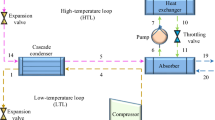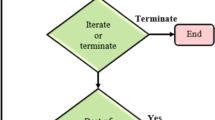Abstract
The estimation of the coefficient of performance (COP) and flow ratio (FR) of absorption cooling systems is an important and complex process. In order to simplify this complex process, a gene expression programming (GEP) model was used. In the present study, GEP has been utilized to evaluate the COP and FR of the LiBr–H2O absorption cooling system. The data used as input parameters consisted of evaporator temperature, condenser temperature, absorber temperature, generator temperature and strong and weak solution concentrations. According to these input parameters, in the GEP models, the COP and FR of the LiBr–H2O absorption cooling system were predicted. The training and testing results in the GEP model have shown an acceptable potential for estimating performance of the absorption cooling system in the considered range.





Similar content being viewed by others
Abbreviations
- COP:
-
Coefficient of performance
- FR:
-
Flow ratio
- \(\dot{m}\) :
-
Mass flow rate (kg/s)
- Q :
-
Heat load (kW)
- T :
-
Temperature (°C)
- XSS :
-
Strong solution concentration (%)
- X WS :
-
Weak solution concentration (%)
- A:
-
Absorber
- C:
-
Condenser
- E:
-
Evaporator
- G:
-
Generator
References
Assilzadeh F, Kalogirou SA, Ali Y, Sopian K (2005) Simulation and optimization of a LiBr solar absorption cooling system with evacuated tube collectors. Renew Energy 30:1143–1159
Sun J, Fu L, Zhang S, Hou W (2010) A mathematical model with experiments of single effect absorption heat pump using LiBr–H2O. Appl Therm Eng 30:2753–2762
Sun J, Fu L, Zhang S (2010) Performance calculation of single effect absorption heat pump using LiBr:LiNO3:H2O as working fluid. Appl Therm Eng 30:2680–2684
Ozgoren M, Bilgili M, Babayigit O (2012) Hourly performance prediction of ammonia-water solar absorption refrigeration. Appl Therm Eng 40:80–90
Beccali M, Cellura M, Longo S, Nocke B, Finocchiaro P (2012) LCA of a solar heating and cooling system equipped with a small water–ammonia absorption chiller. Sol Energy 86:1491–1503
Kalkan N, Young EA, Celiktas A (2012) Solar thermal air conditioning technology reducing the footprint of solar thermal air conditioning. Renew Sustain Energy Rev 16:6352–6383
OECD/IEA (2012) Technology roadmap solar heating and cooling. International Energy Agency, Paris
Yin YL, Zhai XQ, Wang RZ (2013) Experimental investigation and performance analysis of a mini-type solar absorption cooling system. Appl Therm Eng 59:267–277
Gunhan T, Ekren O, Demir V, Hepbasli A, Erek A, Sahin AS (2014) Experimental exergetic performance evaluation of a novel solar assisted LiCl–H2O absorption cooling system. Energy Build 68:138–146
Ketjoy N, Yongphayoon R, Mansiri K (2013) Performance evaluation of 35 kW LiBr–H2O solar absorption cooling system in Thailand. Energy Proc 34:198–210
Eicker U, Pietruschka D (2009) Design and performance of solar powered absorption cooling systems in office buildings. Energy Build 41:81–91
Rosiek S, Batlles FJ (2010) Modelling a solar-assisted air-conditioning system installed in CIESOL building using an artificial neural network. Renew Energy 35:2894–2901
Sözen A, Arcaklioğlu E, Özalp M (2004) Performance analysis of ejector absorption heat pump using ozone safe fluid couple through artificial neural networks. Energy Convers Manag 45:2233–2253
Sözen A, Arcaklioğlu E, Özalp M (2003) A new approach to thermodynamic analysis of ejector–absorption cycle: artificial neural networks. Appl Therm Eng 23:937–952
Şencan A, Yakut KA, Kalogirou SA (2006) Thermodynamic analysis of absorption systems using artificial neural network. Renew Energy 31:29–43
Godarzi AA, Jalilian M, Samimi J, Jokar A, Vesaghi MA (2013) Design of a PCM storage system for a solar absorption chiller based on exergoeconomic analysis and genetic algorithm. Int J Refrig 36:88–101
Chow TT, Zhang GQ, Lin Z, Song CL (2002) Global optimization of absorption chiller system by genetic algorithm and neural network. Energy Build 34:103–109
Manohar HJ, Saravanan R, Renganarayanan S (2006) Modelling of steam fired double effect vapour absorption chiller using neural network. Energy Convers Manag 47:2202–2210
Nazari A (2012) Prediction performance of PEM fuel cells by gene expression programming. Int J Hydrog Energy 37:18972–18980
Landeras G, Lopez JJ, Kisi O, Shiri J (2012) Comparison of gene expression programming with neuro-fuzzy and neural network computing techniques in estimating daily incoming solar radiation in the Basque Country (Northern Spain). Energy Convers Manag 62:1–13
Shiri J, Kisi Ö, Landeras G, Lopez JJ, Nazemi AH, Stuyt LCPM (2012) Daily reference evapotranspiration modeling by using genetic programming approach in the Basque Country (Northern Spain). J Hydrol 414:302–316
Sarıdemir M (2011) Empirical modeling of splitting tensile strength from cylinder compressive strength of concrete by genetic programming. Expert Syst Appl 38:14257–14268
Samadianfard S (2012) Gene expression programming analysis of implicit Colebrook–White equation in turbulent flow friction factor calculation. J Pet Sci Eng 92–93:48–55
Gharagheizi F, Ilani-Kashkouli P, Farahanib N, Mohammadi AH (2012) Gene expression programming strategy for estimation of flash point temperature of non-electrolyte organic compounds. Fluid Phase Equilib 329:71–77
Shiri J, Sadraddini AA, Nazemi AH, Kisi O, Landeras G, Fard AF, Marti P (2014) Generalizability of gene expression programming-based approaches for estimating daily reference evapotranspiration in coastal stations of Iran. J Hydrol 508:1–11
Nazari A, Safarnejad MG (2013) Prediction early age compressive strength of OPC-based geopolymers with different alkali activators and seashell powder by gene expression programming. Ceram Int 39:1433–1442
Marti P, Shiri J, Duran-Ros M, Arbat G, Cartagena FR, Puig-Bargues J (2013) Artificial neural networks vs. Gene Expression Programming for estimating outlet dissolved oxygen in micro-irrigation sand filters fed with effluents. Comput Electron Agric 99:176–185
Güllü H (2014) Function finding via genetic expression programming for strength and elastic properties of clay treated with bottom ash. Eng Appl Artif Intell 35:143–157
Mousavi SM, Mostafavi ES, Hosseinpour F (2014) Gene expression programming as a basis for new generation of electricity demand prediction models. Comput Ind Eng 74:120–128
Mermerdaş K, Güneyisi E, Gesoğlu M, Özturan T (2013) Experimental evaluation and modeling of drying shrinkage behavior of metakaolin and calcined kaolin blended concretes. Constr Build Mater 43:337–347
Ozbek A, Unsal M, Dikec A (2013) Estimating uniaxial compressive strength of rocks using genetic expression programming. J Rock Mec Geotech Eng 5:325–329
Shiri J, Marti P, Singh VP (2014) Evaluation of gene expression programming approaches for estimating daily evaporation through spatial and temporal data scanning. Hydrol Process 28:1215–1225
Traore S, Guven A (2013) New algebraic formulations of evapotranspiration extracted from gene-expression programming in the tropical seasonally dry regions of West Africa. Irrig Sci 31:1–10
Herold KE, Radermacher R, Klein SA (1996) Absorption chillers and heat pumps. CRC Press, Boca Raton
Ozbek A, Unsal M, Dikec A (2013) Estimating uniaxial compressive strength of rocks using genetic expression programming. J Rock Mec Geotech Eng 5:325–329
Ferreira C (2001) Gene expression programming: a new adaptive algorithm for solving problems. Complex Syst 13:87–129
Teodorescu L, Sherwood D (2008) High energy physics event selection with gene expression programming. Comput Phys Commun 178:409–419
Kayadelen C (2011) Soil liquefaction modeling by genetic expression programming and neuro-fuzzy. Expert Syst Appl 38:4080–4087
http://www.gepsoft.com/. Accessed 26 June 2010
Sun DW (1997) Thermodynamic design data and optimum design maps for absorption refrigeration systems. Appl Therm Eng 17:211–221
Author information
Authors and Affiliations
Corresponding author
Rights and permissions
About this article
Cite this article
Dikmen, E. Gene expression programming strategy for estimation performance of LiBr–H2O absorption cooling system. Neural Comput & Applic 26, 409–415 (2015). https://doi.org/10.1007/s00521-014-1723-9
Received:
Accepted:
Published:
Issue Date:
DOI: https://doi.org/10.1007/s00521-014-1723-9




